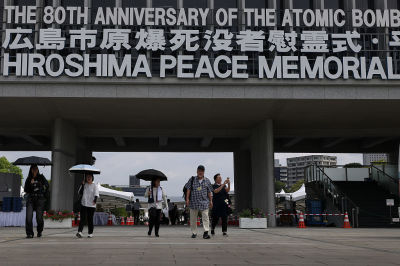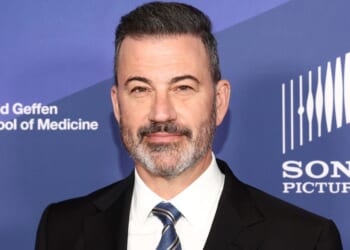
Earlier this week, on August 6th, America as a nation commemorated the 80th anniversary of dropping the atomic bomb on Hiroshima, Japan. We dropped a second atomic bomb on Nagasaki on August 9.
America had reached the culmination of the supersecret Manhattan Project by exploding the first atomic bomb on July 16, 1945, near Los Alamos, New Mexico.
For many decades now, Americans as well as people around the world have vigorously debated whether America should have dropped “the bomb.”
In order to answer that question, one needs to attempt to imagine oneself in the situation of America’s military and political leaders in July 1945. The world had been at war since September 1939, and America had been at war since the Japanese attack on Pearl Harbor, Hawaii, on December 7, 1941.
In the course of helping defeat Hitler and Nazi Germany and Imperial Japan, more than 16 million American men and women had served in the American Armed Forces. America had suffered over a million casualties (407,316 killed and around 671,278 wounded).
America and its political and military leaders were war weary and yet were still facing a fanatical and implacable enemy that showed every sign of continuing to fight “to the last man” in combat situations. On Okinawa (between April 1-June 22, 1945), the Japanese had 110,000 military and between 100,000 and 150,000 civilian deaths before hostilities ended. The Americans suffered 12,500 dead and 49,000 wounded. On Iwo Jima (between February 19-March 26, 1945), the Japanese had 22,000 killed and 216 wounded or captured, and the Americans suffered 6800 dead and 18,000 wounded. This ferocity took place on an island (Iwo Jima) that measured roughly 5 miles by 8 miles in size.
Our military leaders estimated that to invade and subdue Japan would cost between 500,000 and 1,000,000 American military deaths. (As noted earlier, up to that date in the war, America had suffered just over 400,000 killed in action.)
In the interest of full disclosure, my father was a 23-year-old sailor commanding a landing craft of Marines preparing for the invasion of Japan in August 1945. (He had joined the Navy at 18 in 1940, had risen to the rank of Chief Petty Officer after 4 years of service in the Pacific, which included 13 battles – including Midway, the First and Second Battles of the Coral Sea, and the Battle of Leyte Gulf – and his ship was sunk in 1942). His immediate commanding officer had told him the day before we dropped the bomb on Hiroshima that we were expecting 50% casualties in the first wave to go ashore, which my father would be transporting on his landing craft. If we had invaded Japan, there is a 50% chance I wouldn’t be here (I was born in November 1946).
American authorities were already trying to prepare the American public for the fact that they were going to need to continue drafting and enlisting military personnel at the rate of 600,000 to 700,000 annually to meet the military’s wartime needs. (By 1945, that meant 18- and 19-year-olds. All those eligible who were older were already serving.)
Given these grim facts, the U.S. government had already created 500,000 Purple Heart medals to award to Americans wounded in the invasion of Japan. Every purple heart awarded to a wounded American soldier, airman, sailor, or marine since then has come from that cache created in 1945.
The Japanese authorities estimated that their all-out defense of Japan would include at least 20 million military and civilian casualties, followed by mass malnutrition and starvation in the midst of countrywide mass destruction. Records captured after the war reveal that the Japanese were preparing to execute all 170,000 Prisoners of War in their prisons. Some of the prisoners were in the process of digging their own graves when the war ended.
The Second World War would not have ended until mid to late 1947. The massive reconstruction of Europe would have been severely delayed by America’s preoccupation with the continuing war in Japan.
The decision to use the atomic bomb to end the war with Japan was the RIGHT decision. For one thing, when the truth came out that we had the bomb and had not used it, and it caused an additional 500,000 to 1,000,000 American sons, brothers, and fathers to have died, the American people would have demanded their leaders, starting with President Truman, be removed from office and probably tried for treason. Don’t underestimate the anger and outrage of hundreds of thousands of Gold Star parents who believed their loved ones were sacrificed needlessly.
It is certainly a tragedy that 150,000 died at Hiroshima and 64,000 at Nagasaki (plus probably 150,000 more from radiation-caused illnesses over the next five years). However, when you compare these figures with the human costs (Japanese and American) of invading Japan, atomic weapons, up to this point in history, have saved tens of millions of lives more than they have cost.
That reality that atomic weapons have saved many more lives than they have cost is underscored by the fact that it is difficult, if not impossible, to imagine that the Soviet Union and the United States and her N.A.T.O. allies would not have stumbled into a big-time conventional shooting war over control of Berlin and Western Europe without the fear of a nuclear conflagration hanging over their heads. At the very least, millions more Americans and other men and women from Western European countries would have spent years of their lives garrisoning Europe against Soviet invasion.
Similarly, it is difficult to imagine that America and her allies would not have fallen into a widespread conventional war with China over significant parts of Asia without the looming threat of a nuclear war as a deterrent.
Given these realities, up to this point in history, nuclear weapons have saved tens of millions of lives. Of course, that could change in one afternoon if either Pakistan or India were to miscalculate and initiate a first nuclear strike on the other on the Indian subcontinent.
It is certainly true that all people of goodwill should be working to make sure that nuclear weapons do not proliferate to additional countries (especially countries controlled by genocidal maniacs like the Iranian mullahs).
At the same time, all rational people should reject the mirage that we can eliminate nuclear weapons and live in a “nuclear-free world.” You cannot “un-invent” the knowledge of how to make a nuclear bomb. You can read how to do it in the encyclopedia. You can’t put the toothpaste back in the tube after it’s been squeezed out.
If you were able, and that is a big “if,” to get the governments of the world to eliminate all existing nuclear weapons, that would last only until one side began losing the next conventional war. At that point, the losing side would begin building nuclear weapons as soon as possible to save itself from defeat. That is the unpleasant, but true reality of human nature as it is, not necessarily as we would like it to be.
The best recipe for human peace and flourishing is for freedom-loving people operating under democratic processes to maintain a credible nuclear deterrent and to ceaselessly work to maintain nonproliferation of nuclear weapons to additional countries. The more countries that possess nuclear weapons, the more likely they are to be used.
Dr. Richard Land, BA (Princeton, magna cum laude); D.Phil. (Oxford); Th.M (New Orleans Seminary). Dr. Land served as President of Southern Evangelical Seminary from July 2013 until July 2021. Upon his retirement, he was honored as President Emeritus and he continues to serve as an Adjunct Professor of Theology & Ethics. Dr. Land previously served as President of the Southern Baptist Convention’s Ethics & Religious Liberty Commission (1988-2013) where he was also honored as President Emeritus upon his retirement. Dr. Land has also served as an Executive Editor and columnist for The Christian Post since 2011.
Dr. Land explores many timely and critical topics in his daily radio feature, “Bringing Every Thought Captive,” and in his weekly column for CP.

















